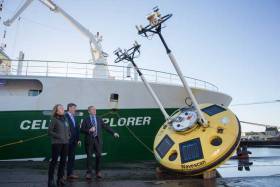Displaying items by tag: marine data buoy
Marine Data Buoy Network Upgraded
The Minister for Agriculture, Food and the Marine, Minister Creed T.D., has announced an investment of over €0.7m in the Marine Data Buoy Network. The additional funding will provide for both ongoing operations and a significant upgrading of the existing infrastructure.
Speaking from the research vessel RV Celtic Explorer, docked in the Port of Cork, Minister for Agriculture, Food and Marine Michael Creed TD said, “I am delighted that the Government has been able to provide significantly increased funding for this vitally important element of our weather and oceanographic observation system. With the impacts of climate change ever more apparent the Government recognizes the importance of increased investment in the existing Marine Data Buoy Network system. This increased expenditure will greatly assist our ocean and weather forecasting capabilities in the years ahead as well as supporting vital climate change research and improving safety at sea. Climate change is one of the greatest challenges facing nations, Governments and decision makers worldwide. With the incidences of extreme weather conditions increasing, the Government’s investment in the Irish Marine Data Buoy Network is very significant but essential. This ongoing and additional funding will enable the Marine Institute to provide essential national services in ocean observation and weather forecasting programmes that have regional and local impact on our livelihoods, safety and the growing blue economy.”
The Marine Data Buoy Network is managed by the Marine Institute in collaboration with Met Eireann. The Network provides crucial data for weather forecasting, risk management for shipping, the fishing community and coastal towns and villages with advanced warnings as well as oceanography research and data on Ireland’s deep waters. This additional injection of €300,000 brings the total investment to over €700,000 for the network in 2018. This investment will enable the upgrade of the Network with new generation buoy platforms and a suite of sensors, replacing the current technology that has been in use since 2008. Dr Peter Heffernan, CEO of the Marine Institute, speaking at the launch said; “Investment in the observation buoys and other infrastructures and research capacities will enable Ireland to be at the forefront in providing critical research capacity and overcoming infrastructure gaps that, in the past, have reduced our ability to address questions of national and global importance with respect to climate and ocean change,”.
During hurricane Ophelia in 2017, waves were recorded at a maximum height of 17.8 meters by the M5 weather buoy off the southeast coast. In 2011, the M4 weather buoy, located 75km north of Belmullet on the northwest coast of Ireland, recorded the largest waves recorded in Irish waters, reaching a maximum height of 20.4 meters. The most westerly buoy, M6, located hundreds of kilometres to the west of Ireland, is a sentinel buoy that gathers critical early data reported hourly on weather approaching Ireland and Europe from the Atlantic. The data buoys provide vital information on atmospheric and sea conditions that influence Ireland’s weather such as atmospheric pressure, air and sea temperature, wind speed and direction. This information helps to validate the weather forecasting models run by Met Éireann, that can, in turn, provide guidance to the national emergency planning efforts during the extreme weather events.
Evelyn Cusack Head of Forecasting from Met Éireann who also attended the launch said; “The data buoys provide vital information about our weather such as atmospheric pressure, air and sea temperature, wind speed and direction. This information is used in the weather forecasting models run by Met Éireann, that provides guidance to the national emergency planning efforts during extreme weather events including storms such as Ophelia and Emma.”
Lord Mayor of Cork, Councillor Mick Finn highlighted the importance of the weather buoy infrastructures to local communities. Mayor Finn stated “As an island nation, the data provided by the buoys is particularly important for communities, coastal and inland, where impending storms may have serious knock-on impacts on local economies. The investment in this technology serves to both warn in the short term while informing over the long-term forecasts. This will help planning for future-proofed protection and safety measures to reduce damage and losses to businesses and infrastructure,” he said.
Minister Creed also welcomed the significant progress made by the Marine Institute in implementing its Strategic Plan, Building Ocean Knowledge, Delivering Ocean Services (2018-2022). Minister Creed stated “Initiatives by the Institute in enhancing the area of research in forecasting ocean and climate change, places Ireland in a unique position to better understand and contribute to national climate adaptation as well as international climate policy. Increasing Ireland’s scientific research capacity in key areas such as sea level change, ocean circulation, and carbon sequestration, is essential and has been highlighted in the Galway Statement on Atlantic Cooperation; the emerging European Ocean Observing System (EOOS) and the Atlantic Ocean Observing System (AtlantOS). The continued investment in the Marine Data Buoy Network will further contribute to building Ireland’s national capacity in physical oceanography and ocean climate science. The ongoing investment targets capacity building, and delivery of relevant knowledge aimed at better understanding the complex interactions between the ocean and climate change is welcomed”
DBSC Boats Asked Not to 'Crash' into Marine Data Buoy
#DUBLIN BAY – Dublin Bay Sailing Club (DBSC) Racing yachts have been asked by race organisers to give a marine data buoy stationed in Scotsman's Bay (Latitude: 53 17.51 N Longitude 006 07.00) a wide berth even though it may be on some DBSC race courses this season.
The buoy carries a lot of expensive research equipment and It's on the periphery of the Red fleet's Thursday courses and also the dinghy Tuesday evening courses.
A combined fleet of 300 boats race under the DBSC burgee on Tuesday, Thursday, Saturday and Sundays making the yachts the biggest leisure users of bay waters.
Competing boats might possibly meet the yellow buoy if on a port-hand tack when sailing a beat from 40 ft. mark to Bay Mark and vice versa.






























































